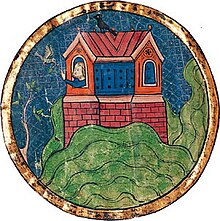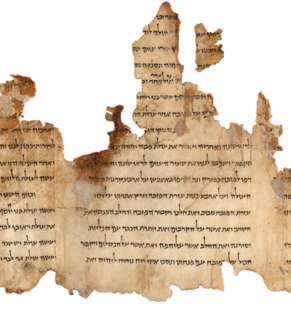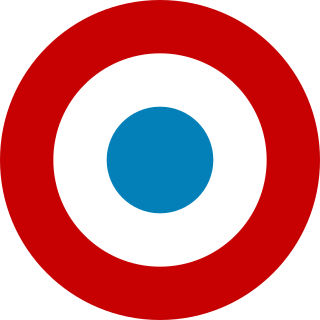
The Bible is a collection of sacred texts or scriptures. Varying parts of the Bible are considered to be a product of divine inspiration and a record of the relationship between God and humans by Christians, Jews, Samaritans, and Rastafarians.

The Septuagint is the earliest extant Greek translation of the Hebrew scriptures from the original Hebrew. It is estimated that the first five books of the Hebrew Bible, known as the Torah or Pentateuch, were translated in the mid-3rd century BCE and the remaining texts were translated in the 2nd century BCE. Considered the primary Greek translation of the Old Testament, it is quoted a number of times in the New Testament,particularly in the Pauline epistles,by the Apostolic Fathers, and later by the Greek Church Fathers.
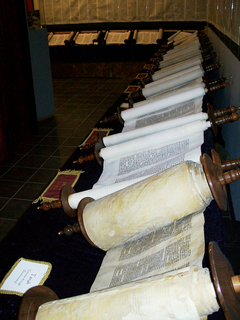
The Hebrew Bible, also called the Tanakh or Mikra, is the canonical collection of Jewish texts, which is also the textual source for the Christian Old Testament. These texts are composed mainly in Biblical Hebrew, with some passages in Biblical Aramaic. The form of this text that is authoritative for Rabbinic Judaism is known as the Masoretic Text (MT), and is divided into 24 books, while the Protestant Bible translations divide the same material into 39 books.

The Samaritan Pentateuch, also known as the Samaritan Torah, is a text of the first five books of the Hebrew Bible, written in the Samaritan alphabet and used as scripture by the Samaritans. It constitutes their entire biblical canon.
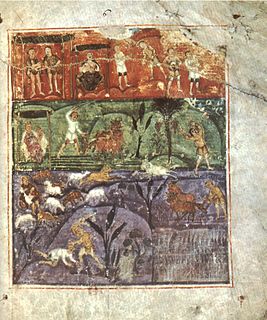
The Ashburnham Pentateuch is a late 6th- or early 7th-century Latin illuminated manuscript of the Pentateuch. Although it originally contained all five books of the Pentateuch, it is now missing the whole of Deuteronomy as well as sections of the other five books.

The Morgan Bible, also called the Crusader Bible or Maciejowski Bible, is a medieval illuminated manuscript picture book Bible of 46 surviving folios. The book consists of miniature paintings of events from the Hebrew bible, set in the scenery and customs of thirteenth-century France, depicted from a Christian perspective. These are now surrounded by text in three scripts and five languages: Latin, Persian, Arabic, Judeo-Persian, and Hebrew.

The Samaritan alphabet is used by the Samaritans for religious writings, including the Samaritan Pentateuch, writings in Samaritan Hebrew, and for commentaries and translations in Samaritan Aramaic and occasionally Arabic.
Micrography, also called microcalligraphy, is a Jewish form of calligrams developed in the 9th century, with parallels in Christianity and Islam, utilizing minute Hebrew letters to form representational, geometric and abstract designs. Colored micrography is especially distinctive because these rare artworks are customarily rendered in black and white.

The book of hours is a Christian devotional book popular in the Middle Ages. It is the most common type of surviving medieval illuminated manuscript. Like every manuscript, each manuscript book of hours is unique in one way or another, but most contain a similar collection of texts, prayers and psalms, often with appropriate decorations, for Christian devotion. Illumination or decoration is minimal in many examples, often restricted to decorated capital letters at the start of psalms and other prayers, but books made for wealthy patrons may be extremely lavish, with full-page miniatures. Books of hours were usually written in Latin, although there are many entirely or partially written in vernacular European languages, especially Dutch. The English term primer is usually now reserved for those books written in English. Tens of thousands of books of hours have survived to the present day, in libraries and private collections throughout the world.
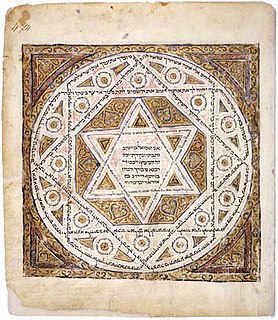
The Leningrad Codex is the oldest complete manuscript of the Hebrew Bible in Hebrew, using the Masoretic Text and Tiberian vocalization. It is dated 1008 CE according to its colophon. The Aleppo Codex, against which the Leningrad Codex was corrected, is several decades older, but parts of it have been missing since 1947, making the Leningrad Codex the oldest complete codex of the Tiberian mesorah that has survived intact to this day.

The Vergilius Vaticanus or Vatican Virgil is a Late Antique illuminated manuscript containing, in its form today, fragments of Virgil's Aeneid and Georgics. It was made in Rome in about 400 A.D., and is one of the oldest surviving sources for the text of the Aeneid and is the oldest and one of only three ancient illustrated manuscripts of classical literature. The two other surviving illustrated manuscripts of classical literature are the Vergilius Romanus and the Ambrosian Iliad.
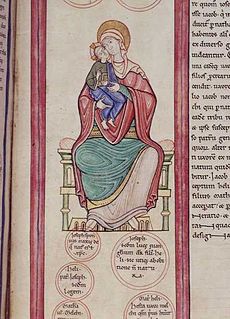
The Parc Abbey Bible is a 12th-century illuminated Bible. It was made in the Leuven region of Belgium at the Abbey of St. Mary of Parc. A colophon on folio 197 indicates that the codex was produced in 1148. The text is Latin and written in proto-gothic book script on vellum. The folios are 437 by 300 mm, with the text block being 340 by 240 mm. The manuscript is illuminated with miniatures, diagrams, decorated borders, and decorated initials. The decorated initials include historiated, inhabited, and foliate initials.
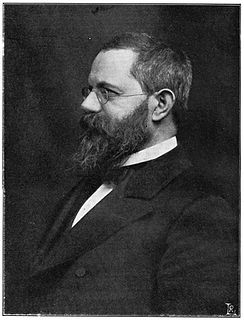
Moses Gaster was a Romanian, later British scholar, the Hakham of the Spanish and Portuguese Jewish congregation, London, and a Hebrew and Romanian linguist. Moses Gaster was an active Zionist in Romania as well as in England, where in 1899 he helped establish the English Zionist Federation. He was the father of Jack and Theodor Gaster and the grandfather of Marghanita Laski. He was also son-in-law to Michael Friedländer and father-in-law to Neville Laski.

The Hours of Catherine of Cleves is an ornately illuminated manuscript in the Gothic art style, produced in about 1440 by the anonymous Dutch artist known as the Master of Catherine of Cleves. It is one of the most lavishly illuminated manuscripts to survive from the 15th century and has been described as one of the masterpieces of Northern European illumination. This book of hours contains the usual offices, prayers and litanies in Latin, along with supplemental texts, decorated with 157 colorful and gilded illuminations. Today, both parts of the manuscript that forms this book are housed at the Morgan Library and Museum in New York City.
Jewish printers were quick to take advantages of the printing press in publishing the Hebrew Bible. While for synagogue services written scrolls were used, the printing press was very soon called into service to provide copies of the Hebrew Bible for private use. All the editions published before the Complutensian Polyglot were edited by Jews; but afterwards, and because of the increased interest excited in the Bible by the Reformation, the work was taken up by Christian scholars and printers; and the editions published by Jews after this time were largely influenced by these Christian publications. It is not possible in the present article to enumerate all the editions, whole or partial, of the Hebrew text. This account is devoted mainly to the incunabula.

The Grandes Heures de Rohan is an illuminated manuscript book of hours, painted by the anonymous artist, the Rohan Master, probably between 1418 and 1425, in the Gothic style. It contains the usual offices, prayers and litanies in Latin, along with supplemental texts, decorated with 11 full page, 54 half page, and 227 small miniatures, decorated with tempera paints and gold leaf. The book margins are decorated with Old Testament miniatures with captions in Old French, in the style of a Bible moralisée. The full page illuminations are renowned for the highly emotional and dramatic portrayal of the agonies of Christ and the grief of the Virgin. According to Millard Meiss, "The Rohan Master cared less about what people do than what they feel. Whereas his great predecessors excelled in the description of the novel aspects of the natural world, he explored the realm of human feeling." Meiss concludes that the Rohan Master was the "greatest expressionist in 15th century France." Today, this manuscript is housed in the Bibliothèque Nationale, Paris, France.

The First Master of the Bible Historiale of Jean de Berry was a French manuscript illuminator active between 1390 and 1400. Little is known about him; his notname comes from a manuscript of the Bible Historiale, now held by the Bibliothèque nationale de France in Paris, in which he painted several miniatures. The manuscript was once owned by John, Duke of Berry, and with most books containing other work ascribed to the artist seems to have been produced in Paris. This would indicate that the artist lived and worked there, producing large secular works as well as religious treatises written in vernacular French.

The Damascus Pentateuch is a 10th century Hebrew Bible codex (Pentateuch), containing the first Five Books of Moses. The codex was copied by an unknown scribe, replete with Masoretic annotations. The manuscript is defective in its beginning, as it starts with Genesis 9:26. It was acquired by the Jewish National and University Library in 1975, and published in a large, two-volume facsimile edition in 1978.

The Birds' Head Haggadah is the oldest surviving illuminated Ashkenazi Passover Haggadah. The manuscript, produced in the Upper Rhine region of Southern Germany in the early 14th century, contains the full Hebrew text of the Haggadah, a ritual text recounting the story of Passover – the liberation of the Israelites from slavery in ancient Egypt – which is recited by participants at a Passover Seder. The text is executed in block calligraphy and accompanied by colorful illustrations of Jews performing the Seder practices and reenacting Jewish historical events. The Birds' Head Haggadah is so called because all Jewish men, women, and children depicted in the manuscript have human bodies with the faces and beaks of birds. Non-Jewish and non-human faces are blank or blurred. Numerous theories have been advanced to explain the unusual iconography, usually tied to Jewish aniconism. The Haggadah is in the possession of the Israel Museum in Jerusalem, where it is on permanent exhibition.
